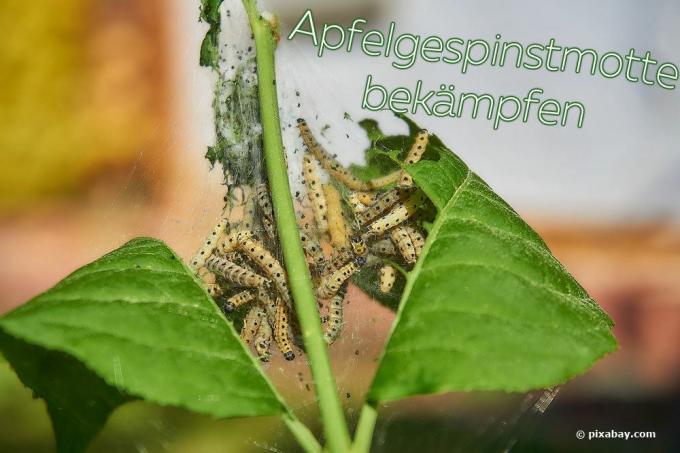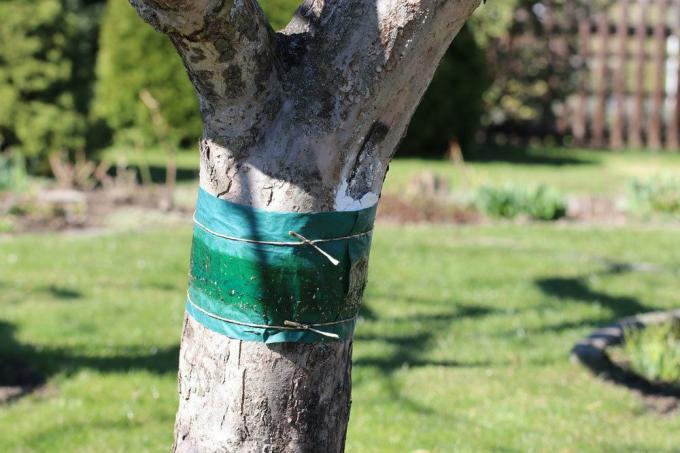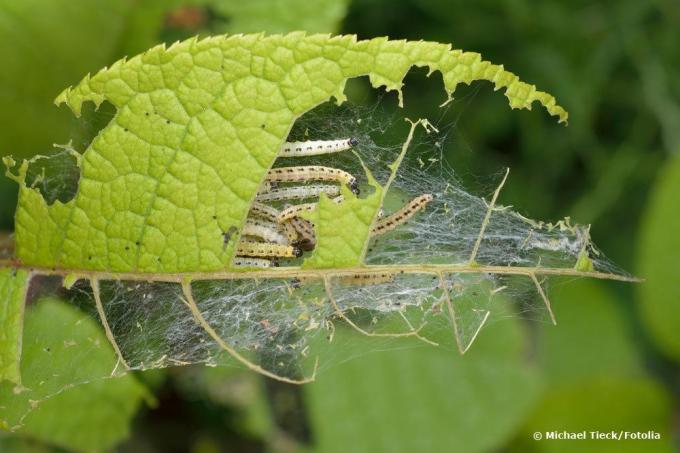
table of contents
- Recognize the web moth
- Get rid of the apple spider moth
- Industrial control agents
- Bacillus thurigiensis spp.
- Thiacloprid
- Home remedies
- Collection of webs
- Glue rings
- Pheromone traps
- Favoring beneficial insects
The apple is the German's favorite fruit. Whether on the orchard or in the garden at home, the apple tree, represented umpteen times, delights with its blossoms and its tasty and rich yield. But time and again it happens that pests threaten trees and crops. How to get rid of the apple moth, one of the most frequent and annoying of the uninvited visitors, you can find out here.
Recognize the web moth
Before you can deal with how to get rid of the apple spider moth, you should first consider yourself rest assured that the observations can actually be attributed to the caterpillars of this widespread butterfly are. Although many of the effects of an infestation are downright obvious, they should be mentioned here again to clarify any uncertainties:
moth
- white, elongated body with approx. 20 mm length
- Wingspan between 16 and 23 millimeters
- White, fringed upper wing with black dot drawing
Caterpillars
- Yellowish to greenish skin color with black dots
- Little to not hairy at all
- Head capsule and legs dark to black in color
- Body length, depending on the stage of development, 18 to 25 millimeters
Webs
- White webs that are reminiscent of cobwebs, but can be much firmer and denser
- Metamorphosis: cocoons of the larvae condense into white, opaque tissues
Damage
- Initially, the leaves are curled up, turning brown and the leaf tips dry out (before web formation from approx. April)
- Small caterpillars can be seen in the rolled-up leaves
- With an increase in the size of the caterpillars, the branches are devastated, and in some cases the leaves become skeletonized
Get rid of the apple spider moth
If you have come to the conclusion that the visitors to the apple tree are actually the apple spider moth, you should act quickly and fight the caterpillars. Otherwise, the tree may be eaten bare in a comparatively short time and at least this year it will no longer produce any yield. In addition, its growth can also be inhibited and even produce limited fruit in the following years. There are a number of different options available to the hobby gardener, from the chemical club to the tried and tested or even unusual home remedies.
Industrial control agents
If you look at the range of insecticides available, you will find a barely manageable variety of different products. However, almost all means that are suitable for combating the caterpillars of the apple spider moth can be traced back to one of two chemical agents.
Note: Although many chemical agents are labeled "bee-friendly", the real effects are the animals that are so important for pollination and thus the yield of apple trees are often not conclusive clarified. Anyone who opts for the massive use of chemicals should therefore be aware that while this will eliminate the pests, the yield of apples can also decrease.
Bacillus thurigiensis spp.
- Type of use: Spraying agent in aqueous solution
- effect: Ingestion by larvae through food, conversion into toxic substances during digestion, The caterpillars are killed by stopping feeding due to symptoms of blood poisoning are similar
- Working time: can only be used during early larval stages, therefore from mid-April to mid-May
- Effects on other organisms: attacks other insects also in the larval stage, no known effects on apple tree itself
Thiacloprid
- Type of use: Spraying agent in aqueous solution
- effect: Ingestion through food and pure skin contact, in the organism paralysis of the transmission of stimuli in the nervous system with subsequent death of the animals
- Working time: Before web formation, i.e. until mid-May at the latest
- effectson other organisms: in high doses harmful to humans and mammals, in the applied dose fatal for numerous other insects on the apple tree, can have a disorienting effect on bees!
Attention: Various insect control agents with the active ingredient thiacloprid have been banned in Germany for several years. Before buying, you should therefore make sure that the product is still approved and can also be used in the orchard at home!
Home remedies
A large number of home remedies are used against the chemical substances from the specialist trade, which usually have far less impact on other, useful insects and of course the tree itself, but usually no less effective in terms of the apple spider moth are effective.
Collection of webs
Although collecting the pests from the tree sounds like a lot of effort with little effect at first, the web moth in particular is easy to get rid of in this way. Because the caterpillars draw attention to themselves very clearly through the web and the cocoons. In addition, the spun-in animals are stationary and can thus be disposed of without any “risk of escape”.
- proceed: Remove webs from the branch with gloves, alternatively rinse with a strong water jet or completely remove the infected branch
- period: after web formation, i.e. from approx. middle of May
- advantages: No effects on beneficial insects on the tree, the tree itself or humans
- disadvantage: only possible after web formation and thus during possible bald erosion
Attention: The collected webs with the larvae should be destroyed in order to prevent the animals from migrating after hatching. Flaming the web with a gas burner after removing it from the tree is very practical.
Glue rings
This method does not start with eliminating the caterpillars, but rather prevents them from migrating to their favorite food. Placed around the trunk, a ring of glue prevents the caterpillars from the ground along the trunk and into the crown with its leaves and the possibility of web formation.
- proceed: Attach the glue rings from the trade well above the height of the grass to avoid bypassing over blades of grass
- period: after hatching, i.e. from mid-April
- advantages: No effects on other animals and people
- disadvantage: prevents the larval stages from migrating, but does not fight animals from eggs already laid on the tree, so mostly only effective in combination with other measures

Pheromone traps
In contrast to most other methods, pheromone traps start before the eggs are laid, i.e. long before the caterpillar population emerges. The traps attract female spider moths and trap them in a pheromone-infused adhesive layer. This means that they are no longer available for reproduction and cannot lay eggs on the apple trees.
- proceed: Hanging the traps in the branches of the trees
- period: before oviposition between June and August
- advantages: When used effectively, no feeding damage, as young animals are prevented from the start, no disadvantages for bees and other beneficial insects
- disadvantage: Low effectiveness in very windy locations, no effects on existing caterpillars, usually to be replaced several times per season due to the long retention time
Favoring beneficial insects
The solution to let others do the work is effective and elegant at the same time. The language here is from the natural enemies of the apple-spun moth. Since different animal species prefer different stages of development of the web moth, this approach can cover almost the entire development cycle of the pest. In addition, the beneficial insects enrich the fauna in the domestic kitchen garden and also have a positive effect on other plants and their possible pests.
- Parasitic wasps and predatory bugs: feel particularly comfortable in a near-natural garden, attack eggs and young larvae stages
- Songbirds: mostly prefer hedges and densely growing solitary shrubs for their nests, and with their brood they destroy countless caterpillars different sizes (example: the average pair of titmice with brood needs around 10,000 larvae, beetles, Moth etc.)
- MiceandHedgehog: live in compost heaps, piles of leaves, dense hedges, etc. and recognize spider moth larvae as a welcome food supplement during migration on the ground to the new host tree



